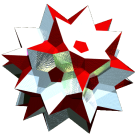dodecahedrically truncated rhombic triacontahedron
©
©
links



| Acronym | chike |
| Name |
chamfered icosahedron, dodecahedrically truncated rhombic triacontahedron |
| |
| Vertex figure | [3,H2], [h5] |
| General of army | (is itself convex) |
| Colonel of regiment | (is itself locally convex) |
| Face vector | 72, 120, 50 |
| Confer | rhote ike |
|
External links |



|
The non-regular hexahedra {(h,H,H)2} have vertex angles h = arccos(1/sqrt(5)) = 63.434949° resp. H = arccos(-sqrt[(5+sqrt(5))/10]) = 148.282526°.
Dodecahedral truncation applies to the dodecahedral vertices (vertex inscribed doe) only. Wrt. the rhote this produces new triangle faces there. These are then face planes of a cutting ike. – The above transition shows a dynamical mutual scaling of ike and rhote. The chamfered ike then is the instance, where all edges happen to have the same length.
Chamfering (or edge-only beveling – here being applied to the ike) flatens the former edges into new (non-regular hexagonal) faces.
There is a deeper, terminal chamfering of the ike too, which then reduces the original faces to nothing. Then the hexagons will become rhombs and the total figure becomes the rhote. – When considering the below provided tegum sum Dynkin symbol, it becomes obvious that this figure also can be seen as a Stott expansion of the rhote.
Incidence matrix according to Dynkin symbol
ax3oo5oc&#zx → height = 0
a = 1+sqrt[(10+2 sqrt(5))/5] = 2.701302
c = sqrt[(10-2 sqrt(5))/5] = 1.051462
(tegum sum of a-ike and (x,c)-srid)
o.3o.5o. | 12 * | 5 0 | 5 0 [h5]
.o3.o5.o | * 60 | 1 2 | 2 1 [3,H2]
-------------+-------+-------+------
oo3oo5oo&#x | 1 1 | 60 * | 2 0
.x .. .. | 0 2 | * 60 | 1 1
-------------+-------+-------+------
ax .. oc&#zx | 2 4 | 4 2 | 30 * {(h,H,H)2}
.x3.o .. | 0 3 | 0 3 | * 20 {3}
© 2004-2025 | top of page |